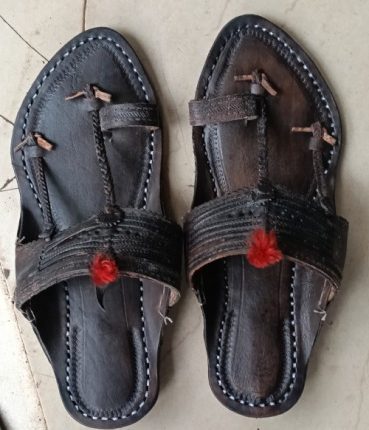Kolhapuri Chappal (GI) Controversy: Global Fashion vs. Local Identity
youtube.com/@theflagpost
July 08, 2025
By Shubham Arya
On June 25, during its Spring/Summer 2026 menswear show in Milan, Italian luxury fashion house Prada debuted shoes inspired by India’s GI-tagged Kolhapuri chappals, which elicited outrage over cultural appropriation. The brand was accused of appropriating traditional Indian craftsmanship without due credit or acknowledgment to its cultural and geographic origins. A major ethical and legal controversy has arisen between the globally famous luxury fashion house Prada and the traditional handmade leather footwear Kolhapuri chappals, which has deep cultural roots in India. Traditional Kolhapuri chappal manufacturers have filed Public Interest Litigation (PIL) lawsuit against Prada in the Bombay High Court. It asserts that the company’s latest footwear series has borrowed the unique design elements of Kolhapuri chappals without authorization or giving due credit. This scandal has raised serious concerns about intellectual property rights, cultural appropriation, and above all, the violation of protection ensured by India’s Geographical Indication (GI) system.
The footwear brand is known for its artistry, which consists of fine hand- stitched and vegetable-dyed leather, Kolhapuri chappals are indigenous to two districts in Maharashtra and one in Karnataka respectively: Kolhapur, Sangli, and Belgaum. The Geographical Indications (GI) of Goods (Registration and Protection) Act of 1999, a legislative mechanism is used to protect goods with specific characteristics or reputations due to origin, granted this unique pair of footwear, the GI status in 2019. The GI tag provides legal protection from unauthorized commercial use as well as legally validating the regional and cultural uniqueness of such goods.
Prada’s launch of a new line of open-toe leather sandals that look like traditional Kolhapuri chappals in terms of soles, toe knots, and leather construction ignited the controversy. Indian craftsmen and cooperatives argue that Prada could hav infringed the GI protection for Kolhapuri chappals by not recognizing the traditional origin of this style. They view this practice as commercial and cultural exploitation, when the artistic work of poor craftspeople is utilized for global gain without equitable benefit-sharing, and not merely an aesthetic imitation act. Legally, this suit is soundly based in India’s GI Act, specifically Section 21, which bars unauthorized persons from using a registered GI in any manner which may cause customers to be misled or which will constitute unfair competition.
In addition, Section 22 enumerates other forms of GI infringement, including blatant abuse, false representations of origin, and actions that discredit or debase the GI’s already acquired reputation. In addition, GI protection is expected to be enforceable worldwide under Articles 22 to 24 due to the fact that both India and Italy—Prada’s country of origin—are signatories to the TRIPS Agreement under the WTO, thus giving affected artisans potential avenues for seeking legal remedies across borders.
By GI tagging, India has for long encouraged the conservation of its native cultural forms and traditional knowledge practices. Such protections are accorded to products such as Mysore silk, Banarasi saris and Darjeeling tea, which express India’s commitment to the sustenance of cultural identity and economic progress through traditional crafts. This broader national initiative is best represented by the Kolhapuri chappal example, which also brings to the forefront the pressing requirement for robust international mechanisms able to effectively counter GI protections in cross-border cases. The issue raises the broader ethical debate of cultural appropriation versus appreciation as well as its legality.
While fashion often takes inspiration from across the globe, there is a deep imbalance in cross-cultural exchange seen in not acknowledging, appreciating, and compensating traditional cultures for their effort. Global brands perpetuate systems of exploitation and erasure when they commodify the beauty of local work without acknowledgment or contributing to the societies of origin. Hence, ethical grounds necessitate that businesses like Prada be accountable, not onl through legal compliance but also through promoting transparency, equitable trade, and true collaboration with communities of artisans.
Finally, the legal action the Kolhapuri chappal manufacturers are contemplating is something greater than a conflict regarding ownership of the design; it is a declaration in favor of the preservation of traditional knowledge systems, the exercise of intellectual sovereignty and the protection of cultural heritage. India can well set a precedent for safeguarding its cultural heritage due to the strict enforcement of GI law and support from global legal systems such as TRIPS. I is important that history not only be preserved but also shared equitably and with morals as globalization and tradition meet increasingly.

